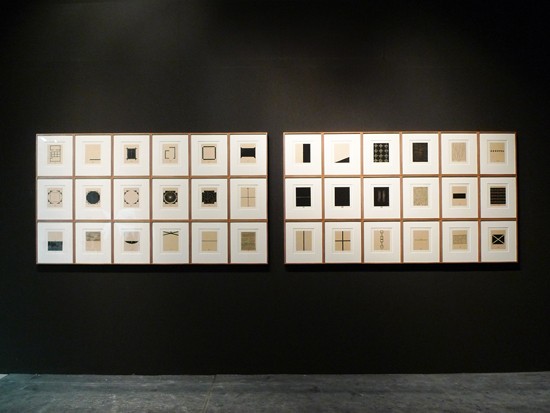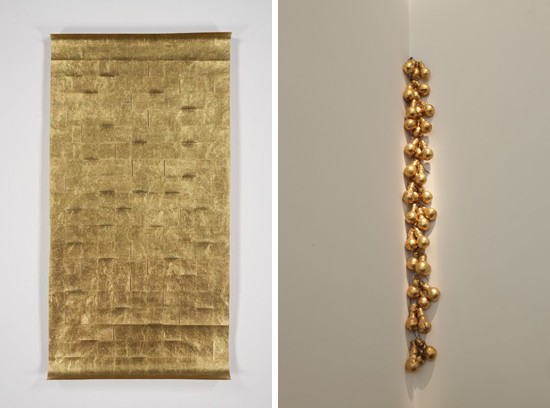 Installation view of Home is a Foreign Place (1999) in “Everybody Agrees: It’s About to Explode,” Indian Pavilion at the 54th Venice Biennale, Arsenale, Venice, 2011. Portfolio of 36 woodcuts with Urdu text printed in black on Kozo paper, mounted on Somerset paper, ed 25, approx 45 x 37.5 cm each, framed. Photo ART iT.
Installation view of Home is a Foreign Place (1999) in “Everybody Agrees: It’s About to Explode,” Indian Pavilion at the 54th Venice Biennale, Arsenale, Venice, 2011. Portfolio of 36 woodcuts with Urdu text printed in black on Kozo paper, mounted on Somerset paper, ed 25, approx 45 x 37.5 cm each, framed. Photo ART iT.Zarina Hashmi was born in 1937 in Aligarh, British India, and is currently based in New York. Distinguished by their evocative sense of materiality, her works in paper and sculpture often combine minimalist, schematic elements with references of deep personal significance. She has been selected as one of four artists and artist groups to represent India in its first official representation at the Venice Biennale, in the exhibition “Everyone Agrees: It’s About to Explode,” curated by Ranjit Hoskote. ART iT corresponded with Zarina to discuss what it means for her to represent India at Venice and her unique perspective on issues of nationality and belonging.
Interview:
ART iT: You lived through the Partition of India but have also spent much of your adulthood in countries ranging from France, Thailand and Japan to the US. How do you feel about being one of the artists selected for India’s first official representation at Venice?
ZH: Neither my family nor I suffered physical harm as a result of the Partition. However, when the country was divided, many families on both sides of the border were separated in the shuffle. The pain we collectively suffered from this dislocation had to do with losing our sense of belonging to India. At this stage of my life, one more group show is of little interest. However, on an emotional level to represent India is finally an acknowledgment of being a member of the nation, after following a kind of “middle passage” for most of my adult life.
ART iT: Entitled “Everyone Agrees: It’s about to Explode,” the India Pavilion will address themes including the idea of the nation-state as something unitary or territorial. What works will you be showing in Venice, and how do you see them relating to the overall concept of the Pavilion?
ZH: Of my works, Ranjit Hoskote has selected: Home is a Foreign Place (1999); Noor (2008); and Blinding Light (2010). The exhibition is an attempt to address the issues of migration and displacement. So far few of the Indian shows have included artists of the Indian diaspora, and it goes to Ranjit’s credit that he has chosen artists who are part of a larger global dialogue.
ART iT: Have you ever considered works such as Home is a Foreign Place, Dividing Line, or Letters from Home to be conscientious reflections on the ideas – ideologies, even – of nations and borders?
ZH: My work was never a conscious reflection on any ideology – it was just a reflection, or narrative, of my own life and the life of many others like me, for whom home has become a foreign place. This is a predicament of the modern age: crossing borders to live in foreign lands and communicating through scraps of papers with quickly jotted notes.
 Left: Blinding Light (2010), 22-carat gold leaf on Okawara paper, 185.42 x 100.33 cm. Courtesy Zarina Hashmi and Luhring Augustine, New York. Right: Noor (Divine Light) (2008), maple wood with formulated gold leaf and leather cord, 13 sets of 3 units each (39 units total), each approx 10.8 x 6.35 cm. Courtesy Zarina Hashmi and Gallery Espace, New Delhi.
Left: Blinding Light (2010), 22-carat gold leaf on Okawara paper, 185.42 x 100.33 cm. Courtesy Zarina Hashmi and Luhring Augustine, New York. Right: Noor (Divine Light) (2008), maple wood with formulated gold leaf and leather cord, 13 sets of 3 units each (39 units total), each approx 10.8 x 6.35 cm. Courtesy Zarina Hashmi and Gallery Espace, New Delhi.ART iT: You often return to the themes of maps and homes (or in the case of the latter, their architectural plans). These are both schematic, but at a human scale maps are necessarily abstract, while even as abstracted diagrams homes can be intensely personal. Can you explain what draws you to these two themes, and two modes of depiction?
ZH: Maps and the memory of homes hold an inextricable significance in the life of a traveler. With a map, I can revisit the city I knew by tracing the streets and rivers. Home is always an interior reality, which, with a floor plan, I can walk through again and again in my imagination.
ART iT: The word “pavilion” itself suggests a temporary or movable structure – the French root means “tent.” Do you feel at home in a place or at an event like Venice, or is the idea of bringing bits and pieces of the world to one spot anathema to the way you have lived so far? What is your relationship to locality?
ZH: You are asking the wrong person this question. I haven’t felt at home in any place for over 50 years. I find the idea of a tent very attractive, especially its aspect of temporariness. Art is about commerce, you bring what you make to the marketplace. I don’t think locality plays any big role in it, although tourism certainly does.
The 54th Venice Biennale, “ILLUMInations,” opens to the public June 4 and continues through November 27.
Return to story index
Venice Biennale – ILLUMInations: 54th International Art Exhibition
